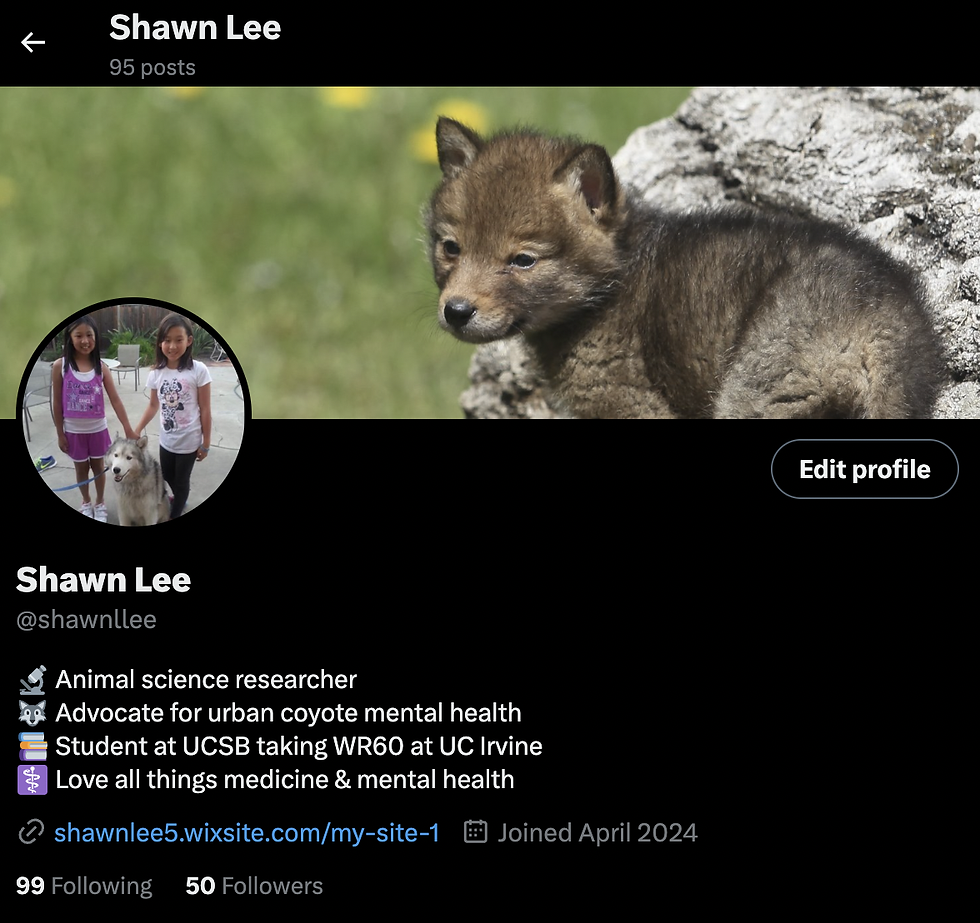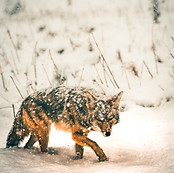Final Blog: Transformative Learning
- Shawn Lee
- Jun 9, 2024
- 3 min read
Hi everyone! As WR60 comes to an end, I wanted to reflect on some things that I learned throughout my journey in this class.
I learned that I can contribute individually to provide a safe environment for urban coyotes.
Majority of the readings I researched for my topic on coyotes was related to what we humans can. have on creating a safe environment for these animals. Before diving into this topic, I assumed that wildlife management was solely the responsibility of local authorities and wildlife experts. However, I now realize that we, as members of urban communities, play a crucial role in ensuring the safety and coexistence of coyotes in our neighborhoods. I can throw away less trash, make sure that my trash cans are inside, drive safely, etc. Each small effort contributes to a larger impact, helping to create a harmonious coexistence with urban coyotes.
I learned that social media is a powerful and effective way to share your research, especially in the 21st century.
In today's digital age, I learned that social media is an incredibly powerful and effective tool for sharing research. This realization has fundamentally changed my approach to disseminating information and engaging with a broader audience. Especially in the 21st century, where connectivity and access to information are at unprecedented levels, social media platforms offer unparalleled opportunities for researchers. Many of us are using social media these days and have grown up with it, so it was really fun and interesting to have Twitter as a main source of communication for this class!
Through Twitter, I was able to easily view my peers' thoughts and research findings in a fun, modern way. It was also just fun to post on Twitter. This not only kept me updated on the latest developments in my field but also facilitated collaboration and idea exchange. Engaging with peers' work on social media platforms enhanced my own understanding and opened up new avenues for research and discussion.
Research, although it comes together in the end, is not a picture perfect process. It takes a lot of time and dedication to create an effective, informative, accurate, and engaging research piece. Through my time researching, I encountered several obstacles.
I would often procrastinate my work.
I often found myself delaying tasks, which added stress and made it challenging to maintain the quality of my work. However, these experiences taught me valuable lessons in time management and perseverance, ultimately helping me improve my research skills and produce a well-rounded final piece. The next time I do research, I definitely want to formulate a solid outline of everything a good amount of time before I begin and turn my assignments in.
New website maker issues.
I had a little trouble making this website through Wix, as I had never used it before and never really understood how websites were made. I didn't realize there were so many aspects to a website. The learning curve was steep, with challenges in customizing templates, integrating multimedia, and ensuring the site was user-friendly and visually appealing. Despite these initial difficulties, the process taught me a great deal about web development and the intricacies involved in creating a functional and engaging online presence.
Conclusion
To finish off WR60 and my final blog, I had an amazing time in this class. I learned so much about coyotes and other canidae and aves species, and gained valuable insights into the role humans play in urban wildlife management. The experience not only expanded my knowledge but also enhanced my research and technical skills, from conducting thorough investigations to creating a website on Wix. Overall, this class has been an enlightening journey that has deepened my understanding of wildlife and the importance of coexistence, and I am grateful for the opportunity to share my findings and grow as a researcher.




Comments